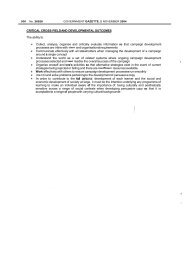The trafficking of children for purposes of sexual exploitation
The trafficking of children for purposes of sexual exploitation
The trafficking of children for purposes of sexual exploitation
Create successful ePaper yourself
Turn your PDF publications into a flip-book with our unique Google optimized e-Paper software.
• International Covenant on Civil and Political Rights (1966) - South Africa signed in 1994<br />
• International Covenant on Economic, Cultural and Social Rights (1966) South Africa signed in<br />
1994<br />
• Convention against Torture and Other Cruel, Inhuman and Degrading Treatment (1984) - South<br />
Africa signed in 1993<br />
• Convention on Consent to Marriage, Minimum Age <strong>for</strong> Marriage and Registration <strong>of</strong> Marriages<br />
(1962) - South Africa acceded in 1993.<br />
2.3. International Labour Organisation (ILO) Instruments<br />
<strong>The</strong> International Labour Organisation (ILO) regards child prostitution as one way in which the<br />
labour <strong>of</strong> <strong>children</strong> is exploited. <strong>The</strong> ILO has developed a number <strong>of</strong> Conventions dealing with<br />
<strong>for</strong>ced labour <strong>of</strong> <strong>children</strong>, among these are:<br />
• Convention 29 Concerning Forced Labour, 1930<br />
• Convention 105 Concerning the Abolition <strong>of</strong> Forced Labour, 1957.<br />
South Africa ratified both these Conventions in 1996. <strong>The</strong>se Conventions deal with <strong>for</strong>ced labour<br />
and the abolition <strong>of</strong> <strong>for</strong>ced labour. Convention 29 prohibits the <strong>for</strong>ced labour <strong>of</strong> <strong>children</strong>.<br />
Convention 105 specifically sets out a number <strong>of</strong> conditions under which <strong>for</strong>ced labour may be<br />
permissible such as, military service, emergency situations, etc. Article 11 <strong>of</strong> this Convention places<br />
an age and gender limitation with regard to those from whom <strong>for</strong>ced labour can be exacted. <strong>The</strong>se<br />
are “able-bodied males <strong>of</strong> an apparent age not less than 18 and not more than 45 years.”<br />
In contrast ILO Convention 182 Concerning the Worst Forms <strong>of</strong> Child Labour identifies child<br />
prostitution as a harmful <strong>for</strong>m <strong>of</strong> child labour.<br />
<strong>The</strong> Worst Forms <strong>of</strong> Child Labour Convention (No. 182) <strong>of</strong> 1999 is aimed at the prohibition and<br />
elimination <strong>of</strong> especially harmful <strong>for</strong>ms <strong>of</strong> child labour. South Africa ratified this Convention on 7<br />
June 2000.<br />
In its Preamble the Convention emphasises the recognition <strong>of</strong> poverty as a cause <strong>of</strong> child labour and<br />
states that<br />
the long-term solution lies in sustained economic growth leading to social progress, in particular<br />
poverty alleviation and universal education.<br />
This part <strong>of</strong> the Preamble not only highlights the importance on the part <strong>of</strong> State Parties to fight the<br />
results <strong>of</strong> poverty such as the <strong>sexual</strong> <strong>exploitation</strong> <strong>of</strong> <strong>children</strong>, but also the need to eliminate the<br />
causes <strong>of</strong> the worst <strong>for</strong>ms <strong>of</strong> child labour such as poverty and socio-economic underdevelopment.<br />
In article 3 <strong>of</strong> the Convention the worst <strong>for</strong>ms <strong>of</strong> child labour are defined as:<br />
a) all <strong>for</strong>ms <strong>of</strong> slavery or practices similar to slavery, such as the sale and <strong>trafficking</strong> <strong>of</strong> <strong>children</strong>,<br />
debt bondage and serfdom and <strong>for</strong>ced and compulsory labour, including <strong>for</strong>ced or compulsory<br />
recruitment <strong>of</strong> <strong>children</strong> <strong>for</strong> use in armed conflict<br />
b) the use, procuring or <strong>of</strong>fering <strong>of</strong> a child <strong>for</strong> illicit activities, in particular <strong>for</strong> the production <strong>of</strong><br />
pornography or <strong>for</strong> pornographic per<strong>for</strong>mances<br />
d) work, which, by its mature or the circumstances in which it is carried out, is likely to harm the<br />
health, safety or morals <strong>of</strong> <strong>children</strong>.<br />
<strong>The</strong> broad definition <strong>of</strong> child labour includes the conditions experienced by <strong>children</strong> while being<br />
trafficked <strong>for</strong> <strong>purposes</strong> <strong>of</strong> <strong>sexual</strong> <strong>exploitation</strong>. Children are 'sold' by their parents or guardians <strong>for</strong><br />
<strong>sexual</strong> <strong>purposes</strong>, which is harmful to their health and safety. In the case <strong>of</strong> the 'sale' <strong>of</strong> a child as a<br />
'bride', the condition under which the child lives and has to 'per<strong>for</strong>m' domestic and <strong>sexual</strong> tasks<br />
would certainly constitute <strong>for</strong>ced and compulsory labour as well as the 'use, procuring [and]<br />
<strong>of</strong>fering <strong>of</strong> a child <strong>for</strong> illicit activities'.<br />
70
















